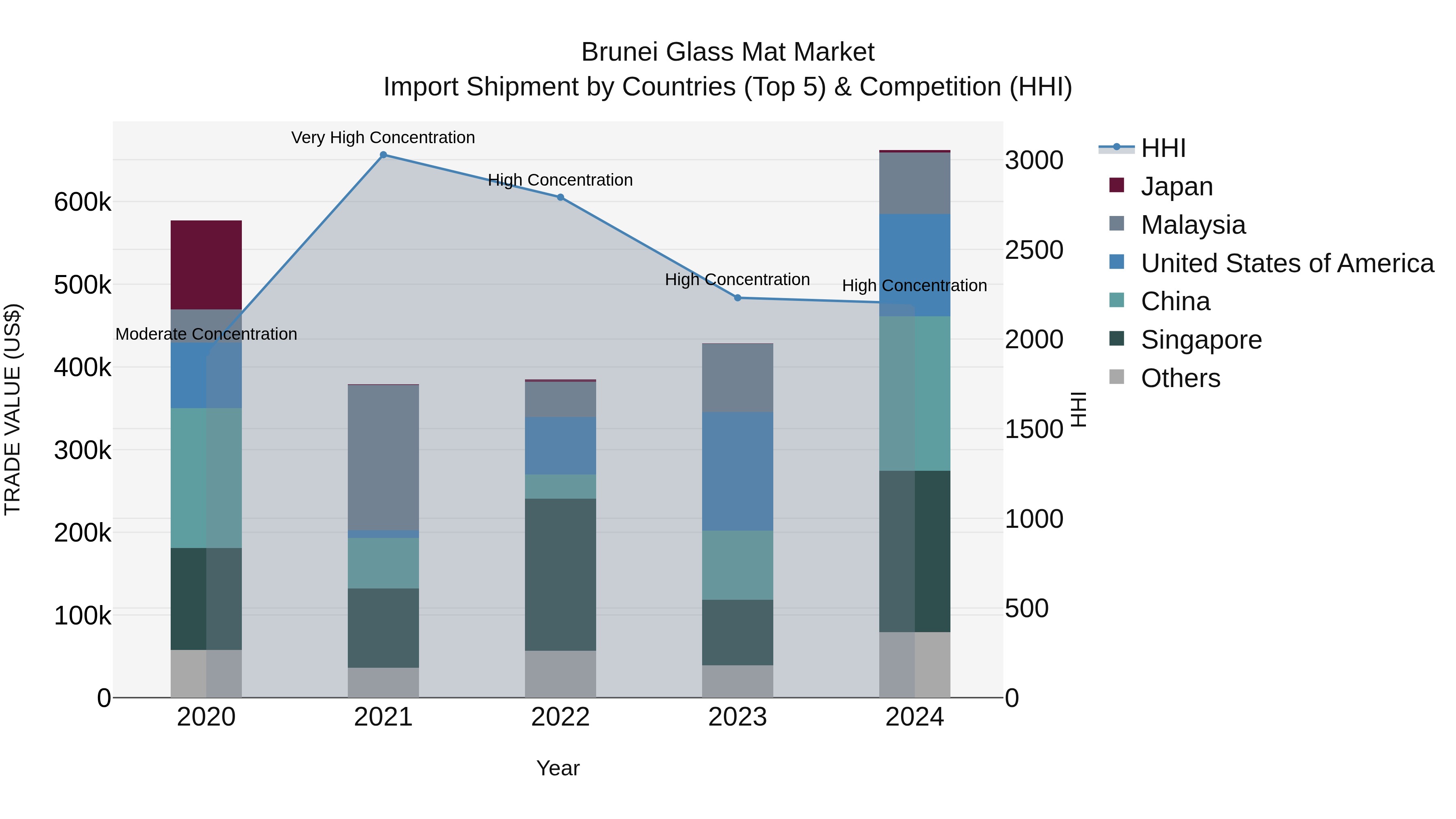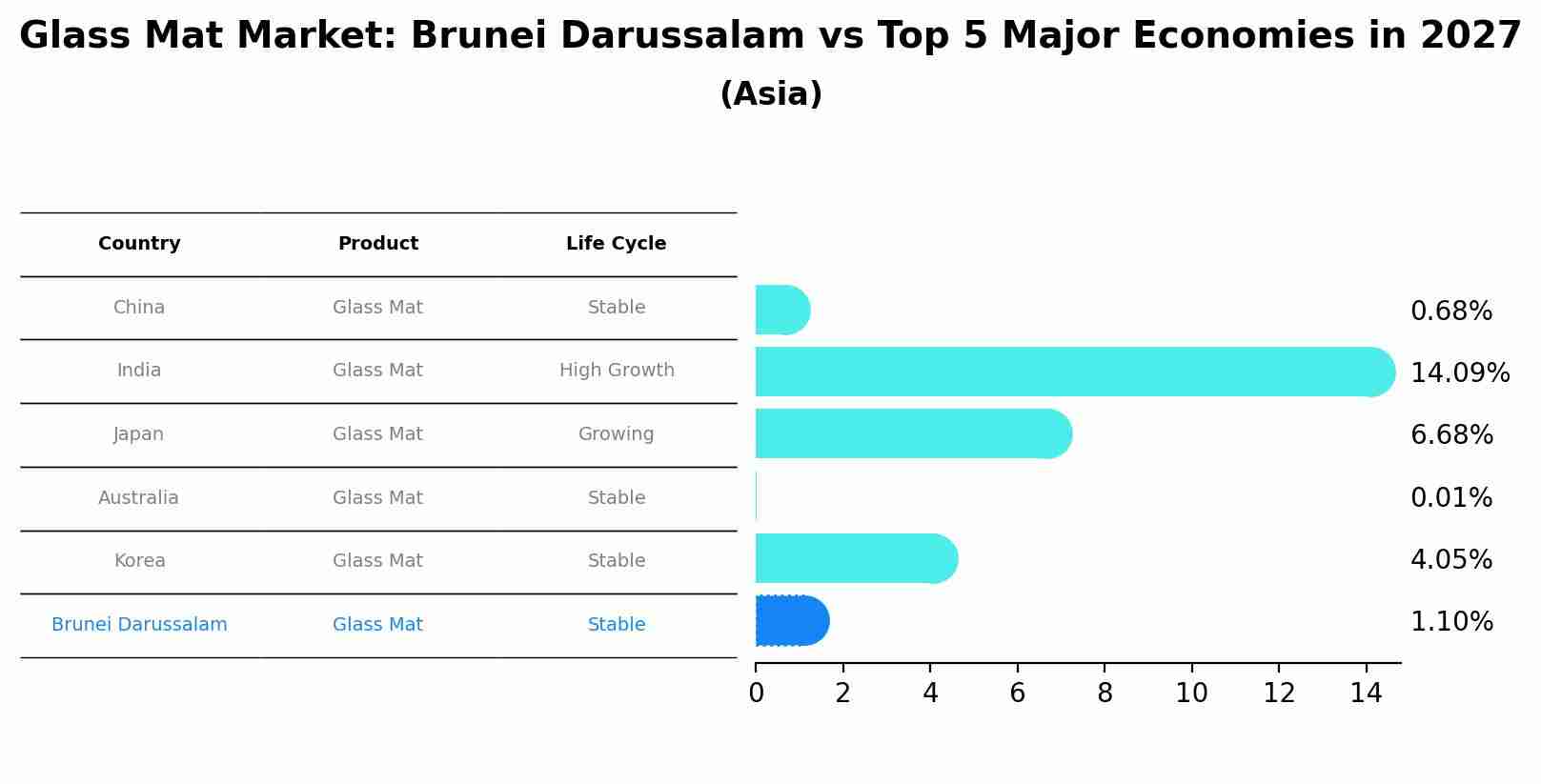Brunei Glass Mat Market (2025-2031) | Companies, Revenue, Industry, Segmentation, Value, Size, Growth, Analysis, Share, Forecast, Trends & Outlook
| Product Code: ETC4913429 | Publication Date: Nov 2023 | Updated Date: Dec 2025 | Product Type: Market Research Report | |
| Publisher: 6Wresearch | Author: Sachin Kumar Rai | No. of Pages: 60 | No. of Figures: 30 | No. of Tables: 5 |
Brunei Glass Mat Market: Top 5 Importing Countries and Market Competition (HHI) Analysis
In 2024, Brunei glass mat import market continued to see significant growth, with top exporting countries being Singapore, China, USA, Malaysia, and the UK. The high Herfindahl-Hirschman Index (HHI) concentration indicates market dominance by a few key players. The compound annual growth rate (CAGR) from 2020-24 stood at a steady 3.5%, while the impressive growth rate of 54.61% from 2023-24 suggests a rapidly expanding market. Brunei glass mat import sector remains dynamic and competitive, driven by strong demand and diverse sources of supply.

Glass Mat Market: Brunei Darussalam vs Top 5 Major Economies in 2027 (Asia)
By 2027, Brunei Darussalam's Glass Mat market is forecasted to achieve a stable growth rate of 1.10%, with China leading the Asia region, followed by India, Japan, Australia and South Korea.

Brunei Glass Mat Market Overview
The glass mat market in Brunei is characterized by its use in various industrial applications, including as a reinforcement material in composites and as a component in building materials. Glass mats provide high strength and durability, contributing to their adoption in construction and manufacturing sectors. The market is influenced by trends in material science and the need for lightweight yet strong materials.
Drivers of the market
The glass mat market in Brunei is growing as industries seek versatile and high-performance reinforcement materials for composites and construction applications. Glass mats, made from glass fibers and resin, are used in applications such as roofing, automotive parts, and marine components. The market is driven by the increasing demand for lightweight and durable materials, advancements in glass mat technology, and the growing use of glass mats in various industrial and consumer products.
Challenges of the market
The Glass Mat Market in Brunei faces challenges due to the limited demand from the construction and automotive industries, which are key consumers of glass mats. The market is constrained by the high cost of glass mat materials and the lack of local production capabilities. Additionally, competition from alternative reinforcement materials and the small size of the Bruneian market restrict growth opportunities. The market also suffers from limited awareness and understanding of the advantages of glass mats.
Government Policy of the market
Bruneis government impacts the glass mat market through regulations on material performance and safety standards. Policies ensure that glass mats used in construction and manufacturing meet quality requirements and provide effective reinforcement. The government supports the use of advanced glass mat technologies to enhance the performance and durability of composite materials. By promoting high standards and innovative solutions, the government aims to support the growth of the glass mat market and improve material efficiency.
Key Highlights of the Report:
- Brunei Glass Mat Market Outlook
- Market Size of Brunei Glass Mat Market, 2024
- Forecast of Brunei Glass Mat Market, 2031
- Historical Data and Forecast of Brunei Glass Mat Revenues & Volume for the Period 2021-2031
- Brunei Glass Mat Market Trend Evolution
- Brunei Glass Mat Market Drivers and Challenges
- Brunei Glass Mat Price Trends
- Brunei Glass Mat Porter`s Five Forces
- Brunei Glass Mat Industry Life Cycle
- Historical Data and Forecast of Brunei Glass Mat Market Revenues & Volume By Mat Type for the Period 2021-2031
- Historical Data and Forecast of Brunei Glass Mat Market Revenues & Volume By Chopped Strand Mat for the Period 2021-2031
- Historical Data and Forecast of Brunei Glass Mat Market Revenues & Volume By Continuous Filament Mat for the Period 2021-2031
- Historical Data and Forecast of Brunei Glass Mat Market Revenues & Volume By Binder Type for the Period 2021-2031
- Historical Data and Forecast of Brunei Glass Mat Market Revenues & Volume By Emulsion Bonded Glass Mat for the Period 2021-2031
- Historical Data and Forecast of Brunei Glass Mat Market Revenues & Volume By Powder Bonded Glass Mat for the Period 2021-2031
- Historical Data and Forecast of Brunei Glass Mat Market Revenues & Volume By Applications for the Period 2021-2031
- Historical Data and Forecast of Brunei Glass Mat Market Revenues & Volume By Drywall Tape & Accessories for the Period 2021-2031
- Historical Data and Forecast of Brunei Glass Mat Market Revenues & Volume By Flooring Enforcement for the Period 2021-2031
- Historical Data and Forecast of Brunei Glass Mat Market Revenues & Volume By Wall Reinforcement for the Period 2021-2031
- Historical Data and Forecast of Brunei Glass Mat Market Revenues & Volume By Roofing And Waterproofing for the Period 2021-2031
- Historical Data and Forecast of Brunei Glass Mat Market Revenues & Volume By Insulation for the Period 2021-2031
- Historical Data and Forecast of Brunei Glass Mat Market Revenues & Volume By End-use Industry for the Period 2021-2031
- Historical Data and Forecast of Brunei Glass Mat Market Revenues & Volume By Marine for the Period 2021-2031
- Historical Data and Forecast of Brunei Glass Mat Market Revenues & Volume By Construction for the Period 2021-2031
- Historical Data and Forecast of Brunei Glass Mat Market Revenues & Volume By Automotive for the Period 2021-2031
- Historical Data and Forecast of Brunei Glass Mat Market Revenues & Volume By Industrial for the Period 2021-2031
- Historical Data and Forecast of Brunei Glass Mat Market Revenues & Volume By Others for the Period 2021-2031
- Brunei Glass Mat Import Export Trade Statistics
- Market Opportunity Assessment By Mat Type
- Market Opportunity Assessment By Binder Type
- Market Opportunity Assessment By Applications
- Market Opportunity Assessment By End-use Industry
- Brunei Glass Mat Top Companies Market Share
- Brunei Glass Mat Competitive Benchmarking By Technical and Operational Parameters
- Brunei Glass Mat Company Profiles
- Brunei Glass Mat Key Strategic Recommendations
Frequently Asked Questions About the Market Study (FAQs):
1 Executive Summary |
2 Introduction |
2.1 Key Highlights of the Report |
2.2 Report Description |
2.3 Market Scope & Segmentation |
2.4 Research Methodology |
2.5 Assumptions |
3 Brunei Glass Mat Market Overview |
3.1 Brunei Country Macro Economic Indicators |
3.2 Brunei Glass Mat Market Revenues & Volume, 2021 & 2031F |
3.3 Brunei Glass Mat Market - Industry Life Cycle |
3.4 Brunei Glass Mat Market - Porter's Five Forces |
3.5 Brunei Glass Mat Market Revenues & Volume Share, By Mat Type, 2021 & 2031F |
3.6 Brunei Glass Mat Market Revenues & Volume Share, By Binder Type, 2021 & 2031F |
3.7 Brunei Glass Mat Market Revenues & Volume Share, By Applications, 2021 & 2031F |
3.8 Brunei Glass Mat Market Revenues & Volume Share, By End-use Industry, 2021 & 2031F |
4 Brunei Glass Mat Market Dynamics |
4.1 Impact Analysis |
4.2 Market Drivers |
4.3 Market Restraints |
5 Brunei Glass Mat Market Trends |
6 Brunei Glass Mat Market Segmentations |
6.1 Brunei Glass Mat Market, By Mat Type |
6.1.1 Overview and Analysis |
6.1.2 Brunei Glass Mat Market Revenues & Volume, By Chopped Strand Mat, 2021-2031F |
6.1.3 Brunei Glass Mat Market Revenues & Volume, By Continuous Filament Mat, 2021-2031F |
6.2 Brunei Glass Mat Market, By Binder Type |
6.2.1 Overview and Analysis |
6.2.2 Brunei Glass Mat Market Revenues & Volume, By Emulsion Bonded Glass Mat, 2021-2031F |
6.2.3 Brunei Glass Mat Market Revenues & Volume, By Powder Bonded Glass Mat, 2021-2031F |
6.3 Brunei Glass Mat Market, By Applications |
6.3.1 Overview and Analysis |
6.3.2 Brunei Glass Mat Market Revenues & Volume, By Drywall Tape & Accessories, 2021-2031F |
6.3.3 Brunei Glass Mat Market Revenues & Volume, By Flooring Enforcement, 2021-2031F |
6.3.4 Brunei Glass Mat Market Revenues & Volume, By Wall Reinforcement, 2021-2031F |
6.3.5 Brunei Glass Mat Market Revenues & Volume, By Roofing And Waterproofing, 2021-2031F |
6.3.6 Brunei Glass Mat Market Revenues & Volume, By Insulation, 2021-2031F |
6.4 Brunei Glass Mat Market, By End-use Industry |
6.4.1 Overview and Analysis |
6.4.2 Brunei Glass Mat Market Revenues & Volume, By Marine, 2021-2031F |
6.4.3 Brunei Glass Mat Market Revenues & Volume, By Construction, 2021-2031F |
6.4.4 Brunei Glass Mat Market Revenues & Volume, By Automotive, 2021-2031F |
6.4.5 Brunei Glass Mat Market Revenues & Volume, By Industrial, 2021-2031F |
6.4.6 Brunei Glass Mat Market Revenues & Volume, By Others, 2021-2031F |
7 Brunei Glass Mat Market Import-Export Trade Statistics |
7.1 Brunei Glass Mat Market Export to Major Countries |
7.2 Brunei Glass Mat Market Imports from Major Countries |
8 Brunei Glass Mat Market Key Performance Indicators |
9 Brunei Glass Mat Market - Opportunity Assessment |
9.1 Brunei Glass Mat Market Opportunity Assessment, By Mat Type, 2021 & 2031F |
9.2 Brunei Glass Mat Market Opportunity Assessment, By Binder Type, 2021 & 2031F |
9.3 Brunei Glass Mat Market Opportunity Assessment, By Applications, 2021 & 2031F |
9.4 Brunei Glass Mat Market Opportunity Assessment, By End-use Industry, 2021 & 2031F |
10 Brunei Glass Mat Market - Competitive Landscape |
10.1 Brunei Glass Mat Market Revenue Share, By Companies, 2024 |
10.2 Brunei Glass Mat Market Competitive Benchmarking, By Operating and Technical Parameters |
11 Company Profiles |
12 Recommendations | 13 Disclaimer |
- Single User License$ 1,995
- Department License$ 2,400
- Site License$ 3,120
- Global License$ 3,795
Search
Thought Leadership and Analyst Meet
Our Clients
Related Reports
- Afghanistan Apparel Market (2026-2032) | Growth, Outlook, Industry, Segmentation, Forecast, Size, Companies, Trends, Value, Share, Analysis & Revenue
- Canada Oil and Gas Market (2026-2032) | Share, Segmentation, Value, Industry, Trends, Forecast, Analysis, Size & Revenue, Growth, Competitive Landscape, Outlook, Companies
- Germany Breakfast Food Market (2026-2032) | Industry, Share, Growth, Size, Companies, Value, Analysis, Revenue, Trends, Forecast & Outlook
- Australia Briquette Market (2025-2031) | Growth, Size, Revenue, Forecast, Analysis, Trends, Value, Share, Industry & Companies
- Vietnam System Integrator Market (2025-2031) | Size, Companies, Analysis, Industry, Value, Forecast, Growth, Trends, Revenue & Share
- ASEAN and Thailand Brain Health Supplements Market (2025-2031) | Strategy, Consumer Insights, Analysis, Investment Trends, Opportunities, Growth, Size, Share, Industry, Revenue, Segments, Value, Segmentation, Supply, Forecast, Restraints, Outlook, Competition, Drivers, Trends, Demand, Pricing Analysis, Competitive, Strategic Insights, Companies, Challenges
- ASEAN Bearings Market (2025-2031) | Strategy, Consumer Insights, Analysis, Investment Trends, Opportunities, Growth, Size, Share, Industry, Revenue, Segments, Value, Segmentation, Supply, Forecast, Restraints, Outlook, Competition, Drivers, Trends, Demand, Pricing Analysis, Competitive, Strategic Insights, Companies, Challenges
- Europe Flooring Market (2025-2031) | Outlook, Share, Industry, Trends, Forecast, Companies, Revenue, Size, Analysis, Growth & Value
- Saudi Arabia Manlift Market (2025-2031) | Outlook, Size, Growth, Trends, Companies, Industry, Revenue, Value, Share, Forecast & Analysis
- Uganda Excavator, Crane, and Wheel Loaders Market (2025-2031) | Strategy, Consumer Insights, Analysis, Investment Trends, Opportunities, Growth, Size, Share, Industry, Revenue, Segments, Value, Segmentation, Supply, Forecast, Restraints, Outlook, Competition, Drivers, Trends, Demand, Pricing Analysis, Competitive, Strategic Insights, Companies, Challenges
Industry Events and Analyst Meet
Whitepaper
- Middle East & Africa Commercial Security Market Click here to view more.
- Middle East & Africa Fire Safety Systems & Equipment Market Click here to view more.
- GCC Drone Market Click here to view more.
- Middle East Lighting Fixture Market Click here to view more.
- GCC Physical & Perimeter Security Market Click here to view more.
6WResearch In News
- Doha a strategic location for EV manufacturing hub: IPA Qatar
- Demand for luxury TVs surging in the GCC, says Samsung
- Empowering Growth: The Thriving Journey of Bangladesh’s Cable Industry
- Demand for luxury TVs surging in the GCC, says Samsung
- Video call with a traditional healer? Once unthinkable, it’s now common in South Africa
- Intelligent Buildings To Smooth GCC’s Path To Net Zero


















